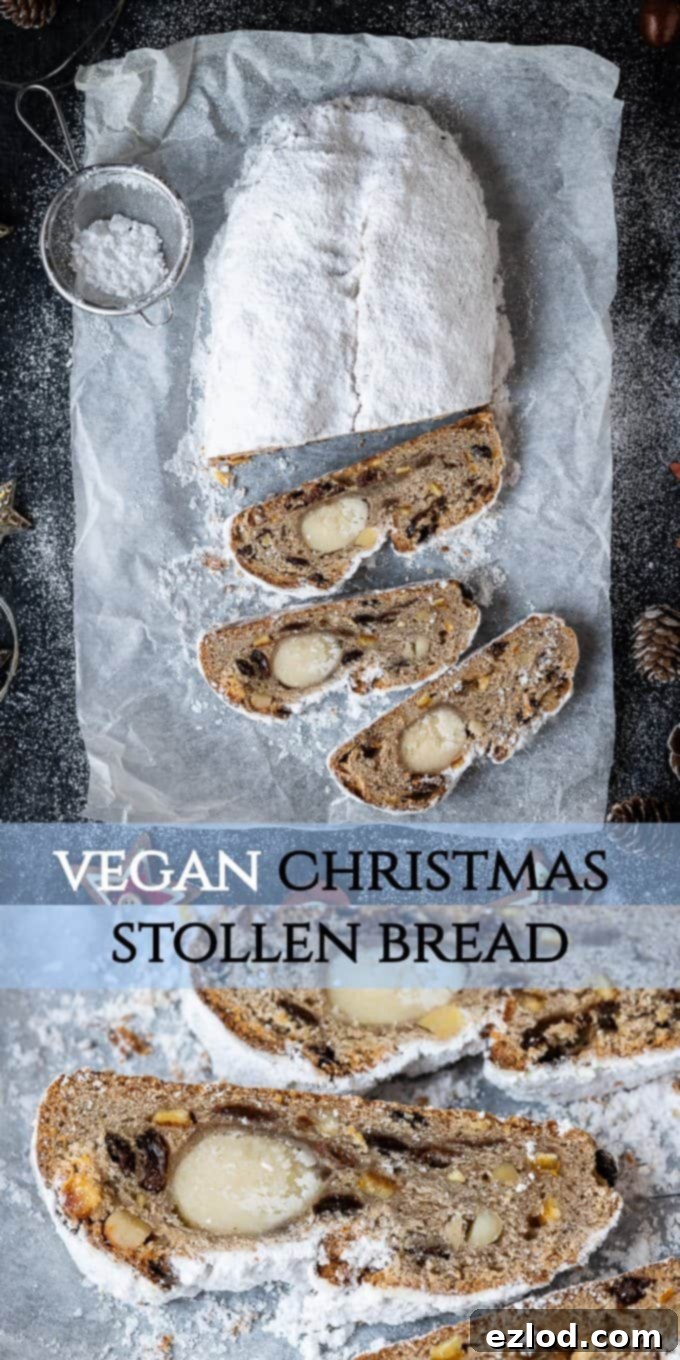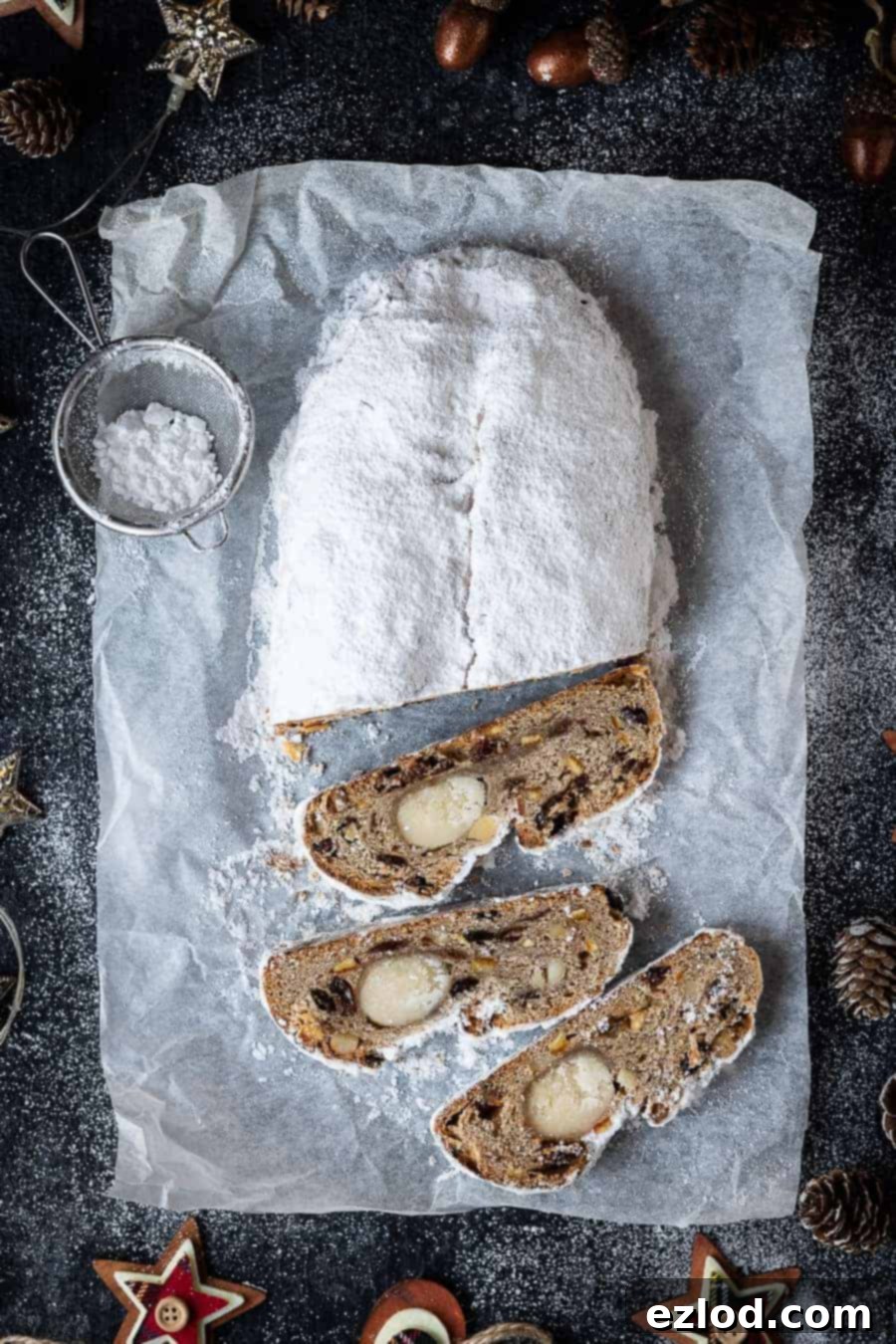Perfect Vegan Stollen Recipe: A Festive, Dairy-Free German Christmas Bread
Discover how to make the ultimate vegan stollen, a traditional German Christmas bread that’s rich, fruity, and perfectly spiced. This dairy-free and eggless version captures all the classic flavors, complete with a delicious marzipan filling. Bake it for an immediate festive treat or let it mature for weeks to deepen its exquisite taste!
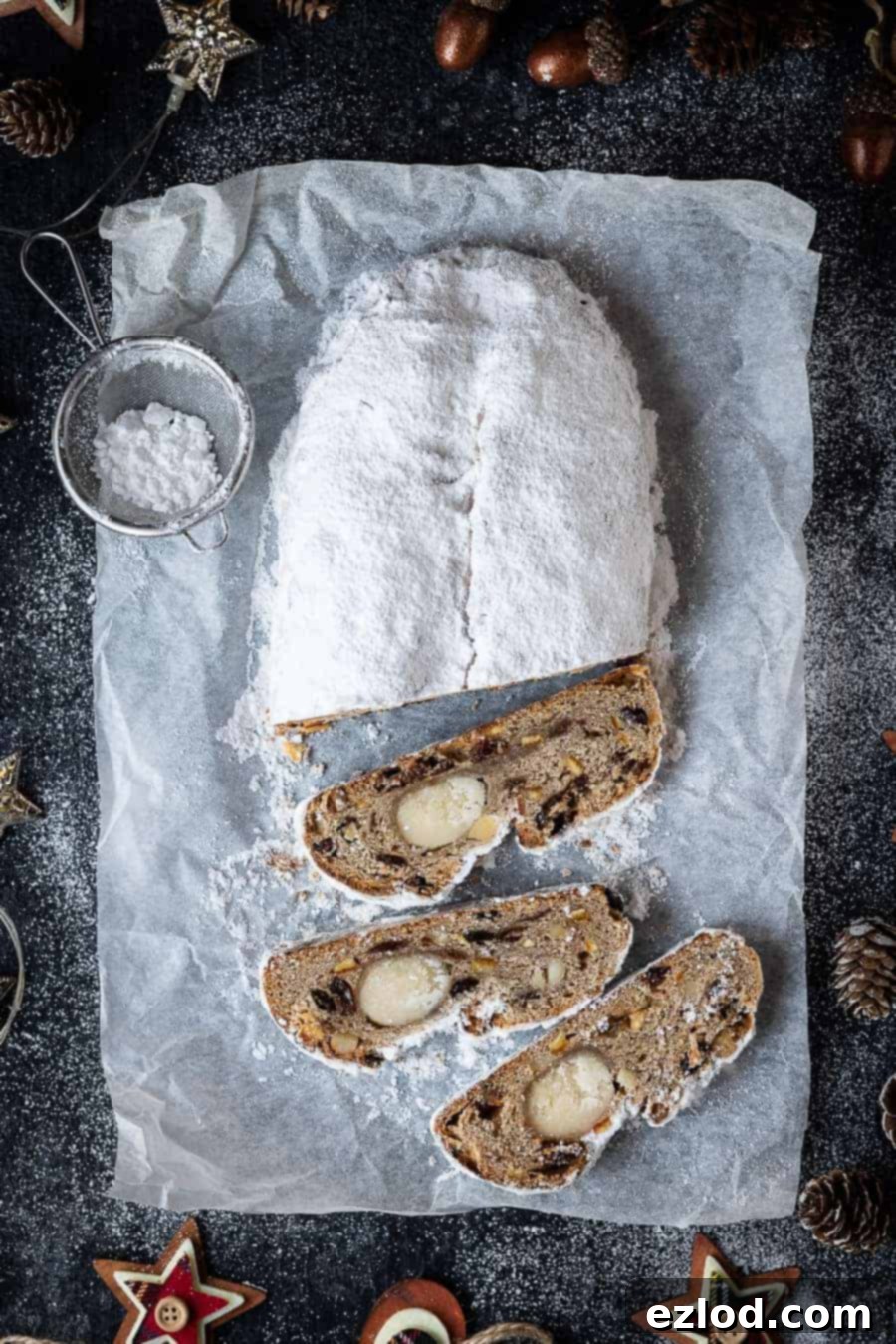
As the holiday season approaches, there’s a particular warmth that comes from traditions, especially those tied to baking. For many, including myself, the arrival of Christmas signals the return of beloved treats, and among them, stollen holds a special place. This dense, wonderfully cakey, and deeply fruity German bread, often graced with a sweet marzipan filling, is an absolute festive delight.
While vegan-friendly stollen options have become more accessible in supermarkets, the true magic, I believe, lies in crafting it from scratch at home. There’s an unparalleled satisfaction in achieving that perfect homemade quality. My journey to perfecting this vegan stollen recipe took four dedicated attempts, but every effort was worth it. The final result is a triumph: a lusciously dense, moist, and incredibly flavourful loaf, generously studded with rum-soaked fruits and featuring a delectable marzipan heart.
Stollen is not your typical light and airy bread; it’s designed to be substantial, boasting a high fat content that is key to its remarkable keeping qualities. This richness ensures it remains moist and delicious for an extended period without drying out. Consequently, its texture leans more towards a dense cake than a traditional bread, making it uniquely satisfying.
I’ll be honest, embarking on this vegan stollen recipe is truly a labour of love. It requires patience, primarily because of its heavily enriched dough, which demands significant time to rise. To achieve the ideal texture and flavour, you’ll need to spread the preparation over three days. But don’t let the timeline deter you! A large portion of this time is passive, simply allowing the dough to rest and develop. Plus, this recipe yields two magnificent loaves of stollen, making your investment of time doubly rewarding.
During my testing phases, I experimented with shorter rising times, but the loaves turned out excessively heavy and dense. This confirmed that the lengthy, patient rising process is absolutely essential for that wonderfully tender, rich crumb that defines a truly exceptional stollen.
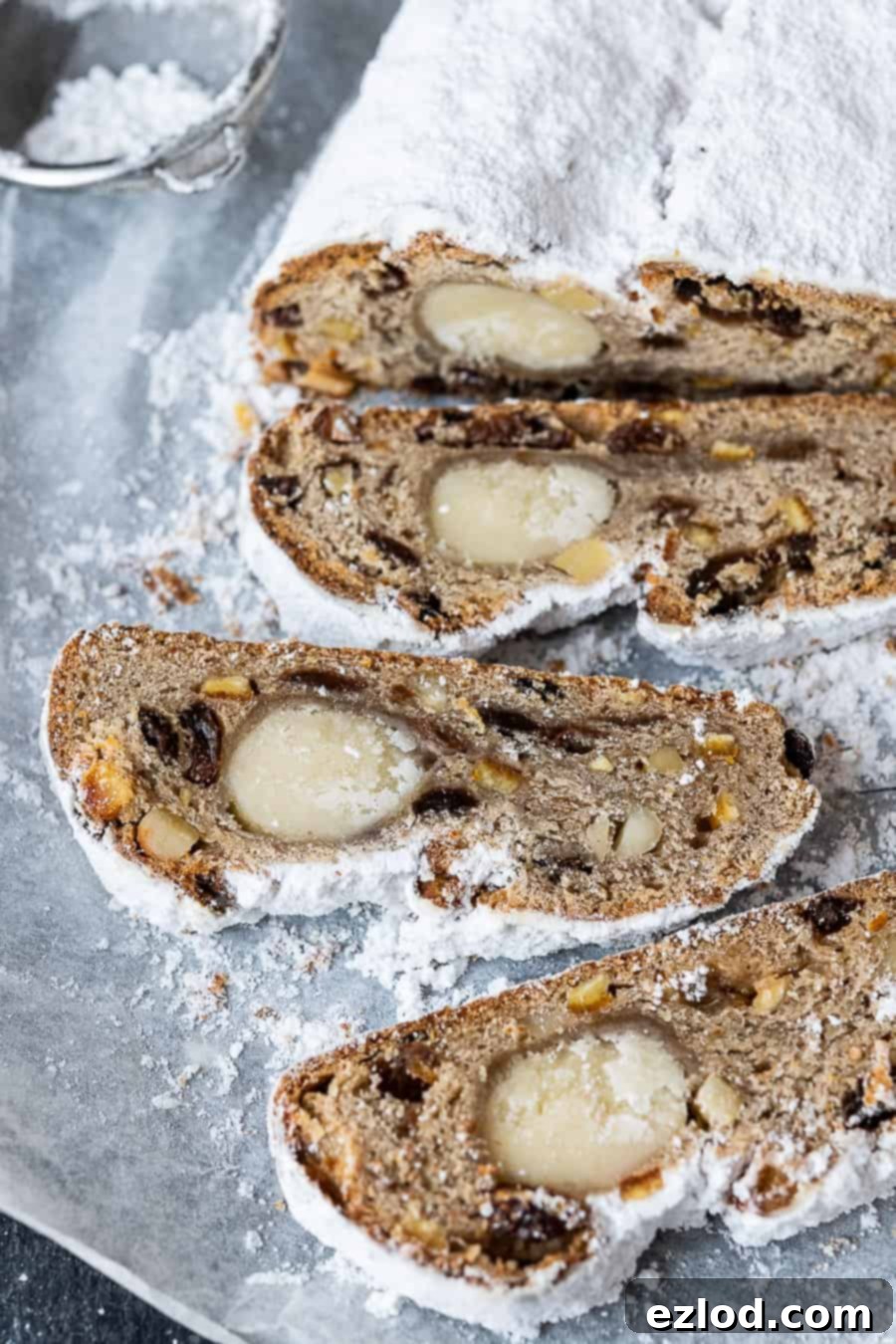
The History and Charm of Stollen
Before diving into the recipe, it’s worth appreciating the rich history of stollen. Originating in Dresden, Germany, stollen dates back to the 14th century, initially a much plainer, fasting-friendly bread made during Advent. Over centuries, it evolved, gradually incorporating more luxurious ingredients like butter, sugar, dried fruits, and spices, especially after Pope Innocent VIII granted permission for butter consumption during Advent in 1491, thanks to the “Butter Letter.”
The distinctive shape of stollen is traditionally said to represent the infant Jesus wrapped in swaddling clothes. Its rich, spiced, fruit-filled nature became synonymous with Christmas, and the elaborate baking process, often involving maturation, became a cherished part of holiday preparations. Modern stollen, particularly the famous Dresden Christstollen, is a protected geographical indication, celebrated globally for its unique flavor and tradition.
Why Make Homemade Vegan Stollen?
Making vegan stollen at home is not just about accommodating dietary needs; it’s about embracing a time-honored tradition and infusing it with personal care. A homemade stollen offers a depth of flavor and a tender texture that store-bought versions often struggle to match. By choosing a vegan recipe, we’re making this beloved classic accessible to everyone, ensuring that those who follow a plant-based diet, or have dairy and egg allergies, can also enjoy this quintessential Christmas treat.
Creating a vegan version of an enriched bread like stollen presents unique challenges, primarily in replicating the richness and structure that dairy butter and eggs provide. This recipe has been meticulously developed to overcome those hurdles, utilizing high-quality vegan block butter and plant-based milk to achieve an authentic, moist, and wonderfully dense crumb. The result is a stollen that stands shoulder-to-shoulder with its traditional counterpart, full of festive spices, zesty citrus, and sweet marzipan.
The Craft of Making Vegan Stollen: A Detailed Guide
(For precise ingredient measurements and a concise instruction list, please refer to the recipe card located below this section.)
For optimal results, strict adherence to the recipe is highly recommended. Always prioritize gram measurements using a digital scale over cup conversions, as cup measurements can lack the necessary accuracy for consistent baking outcomes. Your dedication to precision will be rewarded!
Day 1: Preparing the Fruity Infusion
Your stollen journey begins on the evening of the first day by preparing the fruit mixture. In a bowl, combine plump raisins, vibrant candied mixed peel, and a generous splash of rum. The rum isn’t just for flavor; it helps to soften and plump up the dried fruits, infusing them with an irresistible aroma and moisture that will be crucial for the stollen’s overall texture. Give the mixture a thorough stir, cover it tightly, and allow it to soak overnight. This simple step is vital for developing the deep, rich fruitiness characteristic of traditional stollen.
Day 2: Crafting the Enriched Dough
The second day is dedicated to assembling and fermenting your stollen dough. Begin by stirring some finely chopped almonds into your rum-soaked fruit mixture from the previous night. These nuts will add a lovely textural contrast and a subtle, nutty flavour to the finished bread.
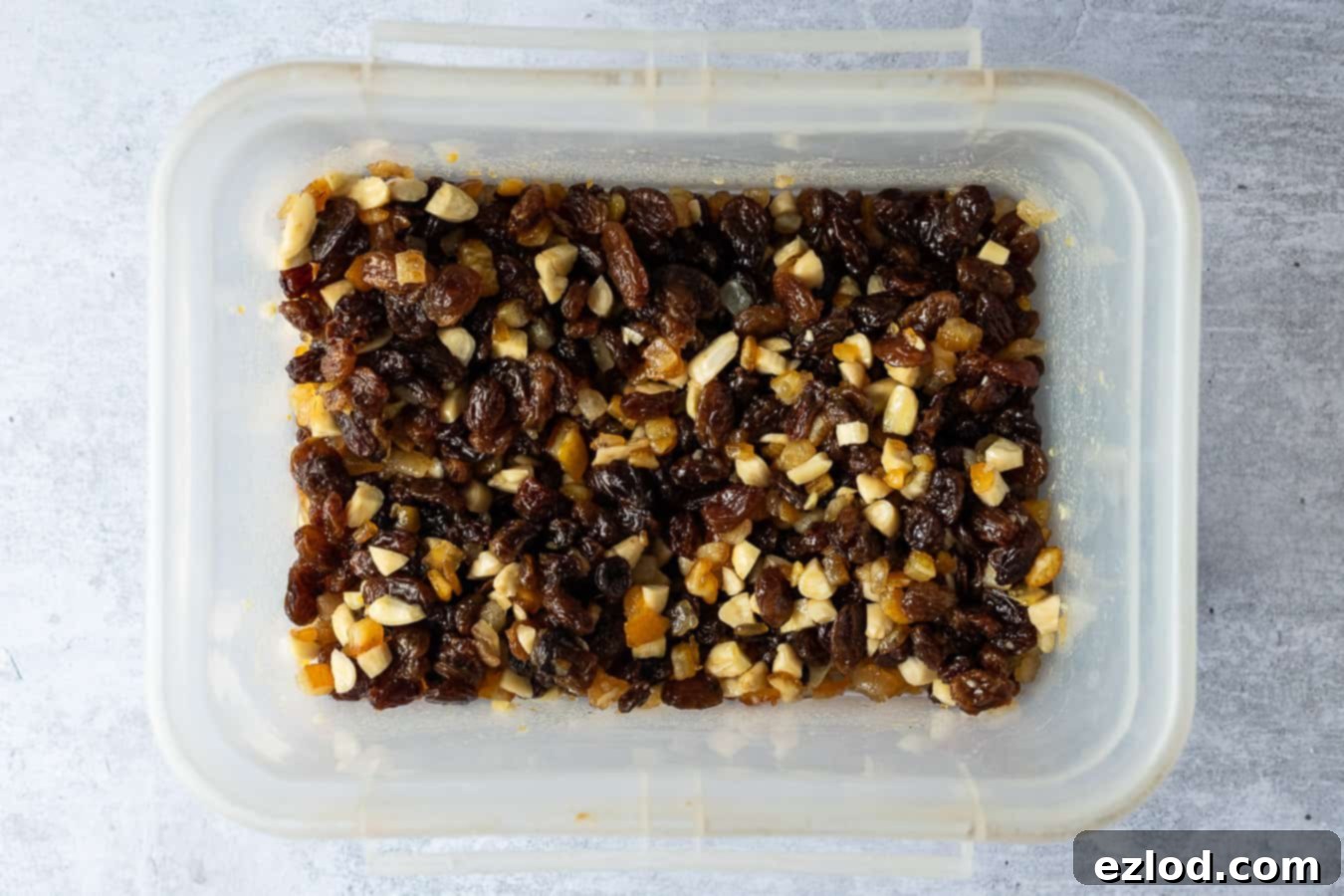
Next, in the bowl of a stand mixer fitted with a dough hook, combine your dry ingredients: plain flour, instant yeast, granulated sugar, salt, and an aromatic blend of ground cinnamon, allspice, cloves, cardamom, and nutmeg. These spices are the heart of stollen’s festive flavour profile, evoking the essence of Christmas.
To this, add the wet ingredients: lukewarm unsweetened non-dairy milk (soy milk is highly recommended for its richness and neutral flavour), vanilla and almond extracts for depth, and the finely grated zest of fresh orange and lemon, which provides a bright, citrusy lift. Crucially, incorporate a generous amount of softened vegan block butter. For the best texture, it’s paramount to use a solid block butter or margarine, rather than the spreadable varieties often found in tubs. Brands like Naturli Vegan Block work exceptionally well due to their higher fat content and firmer consistency, mimicking traditional butter closely.
Mix these ingredients on a low speed until they just come together to form a shaggy, rough dough. Then, increase the mixer speed and knead for approximately 10 minutes. The goal is to develop the gluten sufficiently so that the dough becomes beautifully smooth, elastic, and pulls away cleanly from the sides of the bowl. If you’re kneading by hand, you’ll need 10-15 minutes of vigorous kneading on an unfloured surface until the dough is smooth, pliable, and no longer sticky.
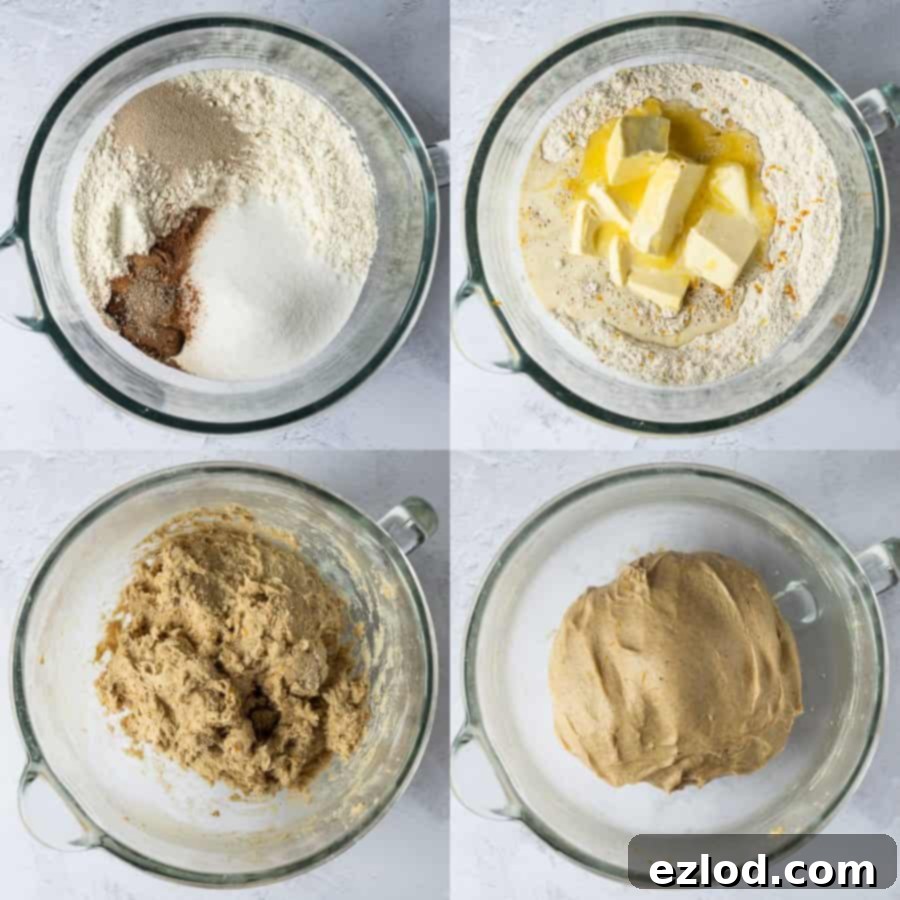
Once your dough is perfectly smooth, gently incorporate the soaked fruit and nut mixture. Knead just until the fruits and nuts are evenly distributed throughout the dough. Over-kneading at this stage can tear the gluten strands developed earlier, so be mindful not to overdo it.
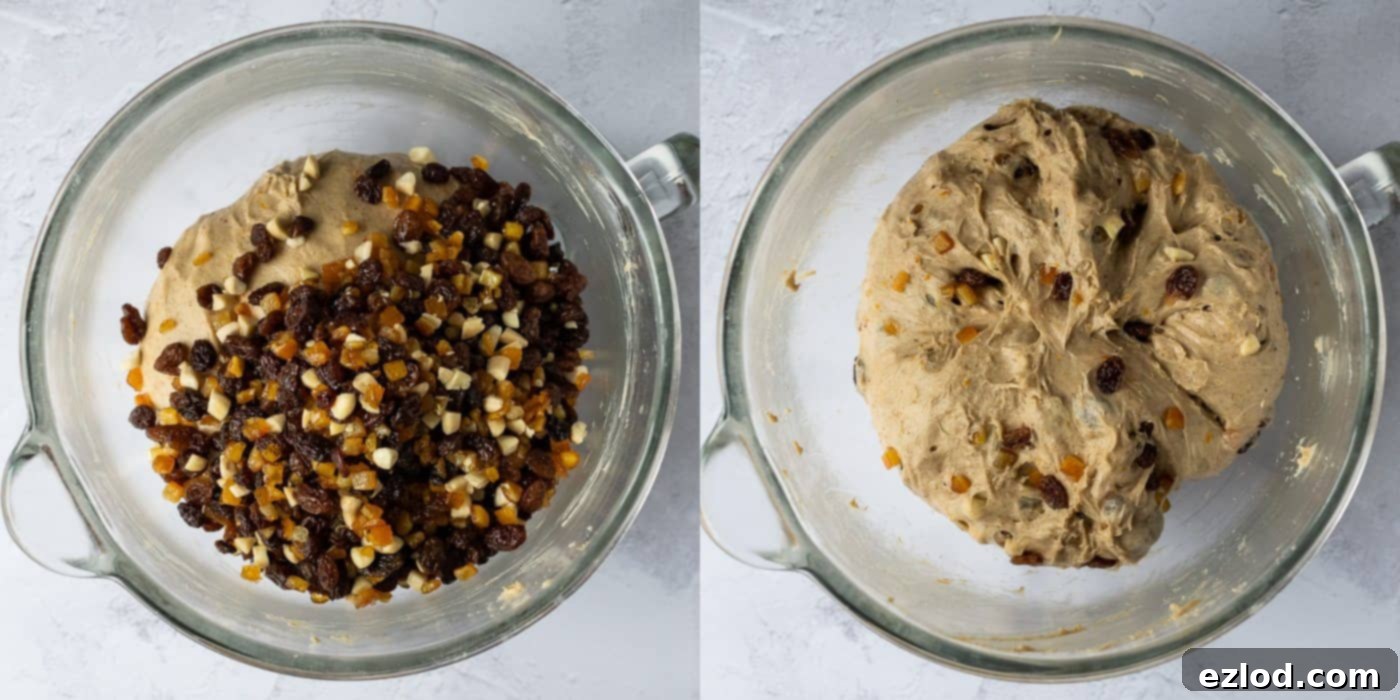
Transfer the dough to a lightly oiled bowl, cover it securely, and place it in a warm spot to begin its first rise. This initial bulk fermentation is critical for flavor development and can take anywhere from 5 to 8 hours, depending on the ambient temperature. The dough should nearly double in size, indicating that the yeast is active and working its magic.
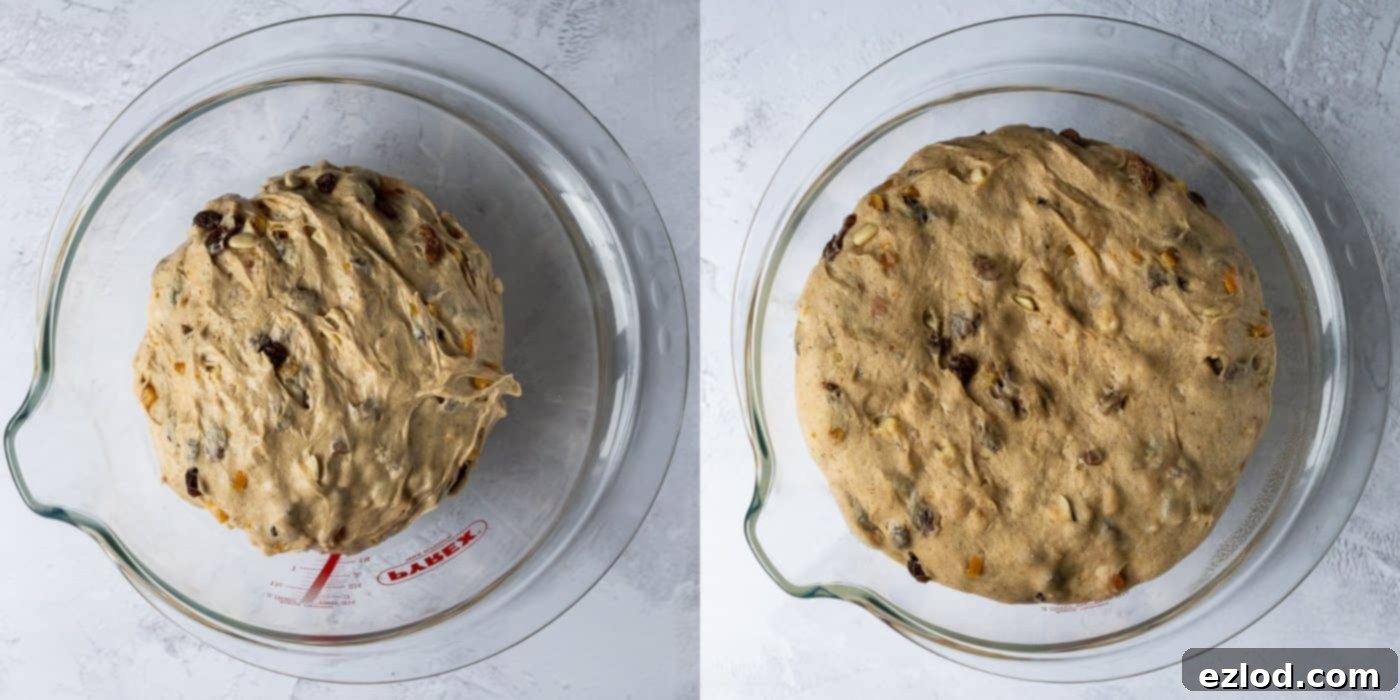
After this extensive rise, the dough is ready for its overnight chill. Place the covered bowl in the refrigerator. This cold fermentation period is not merely for convenience; it significantly enhances the stollen’s flavour, allowing the spices and fruit to meld further, and also makes the dough much easier to handle the following day.
Day 3: Shaping, Baking, and Finishing
On the final day of preparation, remove the chilled dough from the refrigerator and let it come to room temperature for approximately 2 hours. This step is important for the dough to become pliable again and to ensure an even second rise.
Gently ‘knock back’ the dough to release the air, then divide it into two equal pieces. For accuracy and consistency between your two loaves, using a kitchen scale is highly recommended. On a lightly floured surface, roll out each piece of dough into a rough rectangle, about 1 to 1 ½ cm thick.
Divide your marzipan in half, rolling each portion into a log slightly shorter than your dough rectangles. Place each marzipan log just off-center on the rolled-out dough. This creates the traditional stollen shape and ensures a delightful surprise in every slice.
Fold the smaller half of the dough over the marzipan log, then bring the other, larger half over the top. Gently press down to seal the edges, ensuring the marzipan is completely encased and the ends are also well-sealed.
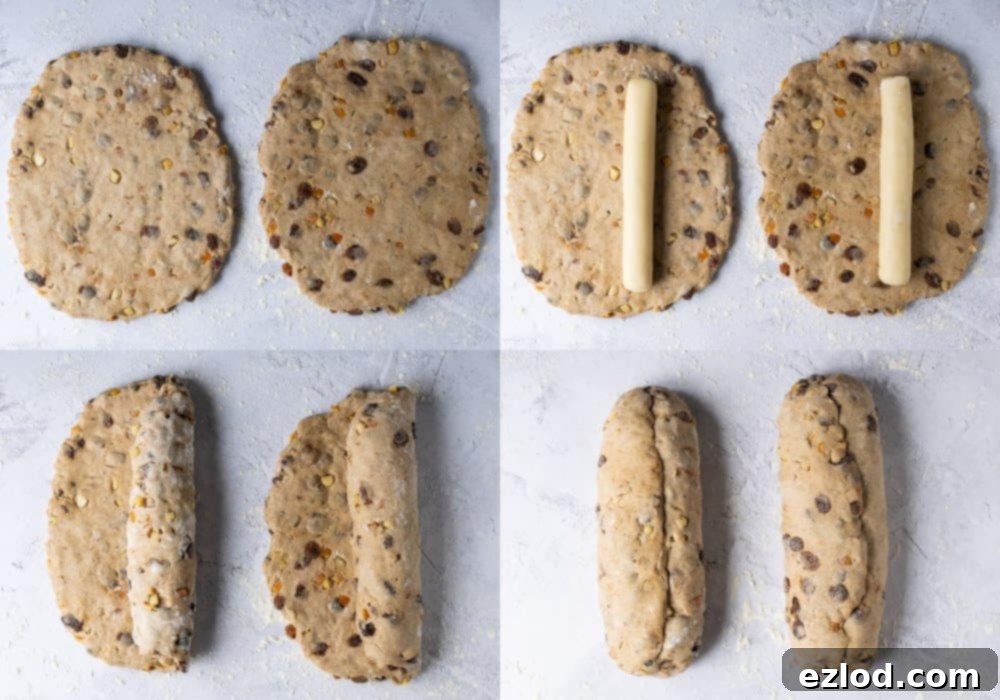
Arrange your two shaped stollen loaves well-spaced apart on a baking sheet lined with greaseproof paper. Loosely cover them and set them aside in a warm place for their final rise. This second rise will take about 3-4 hours, and the loaves will increase in size by approximately 50% – they will not quite double. While they are rising, preheat your oven to 180°C/350°F/gas mark 4.
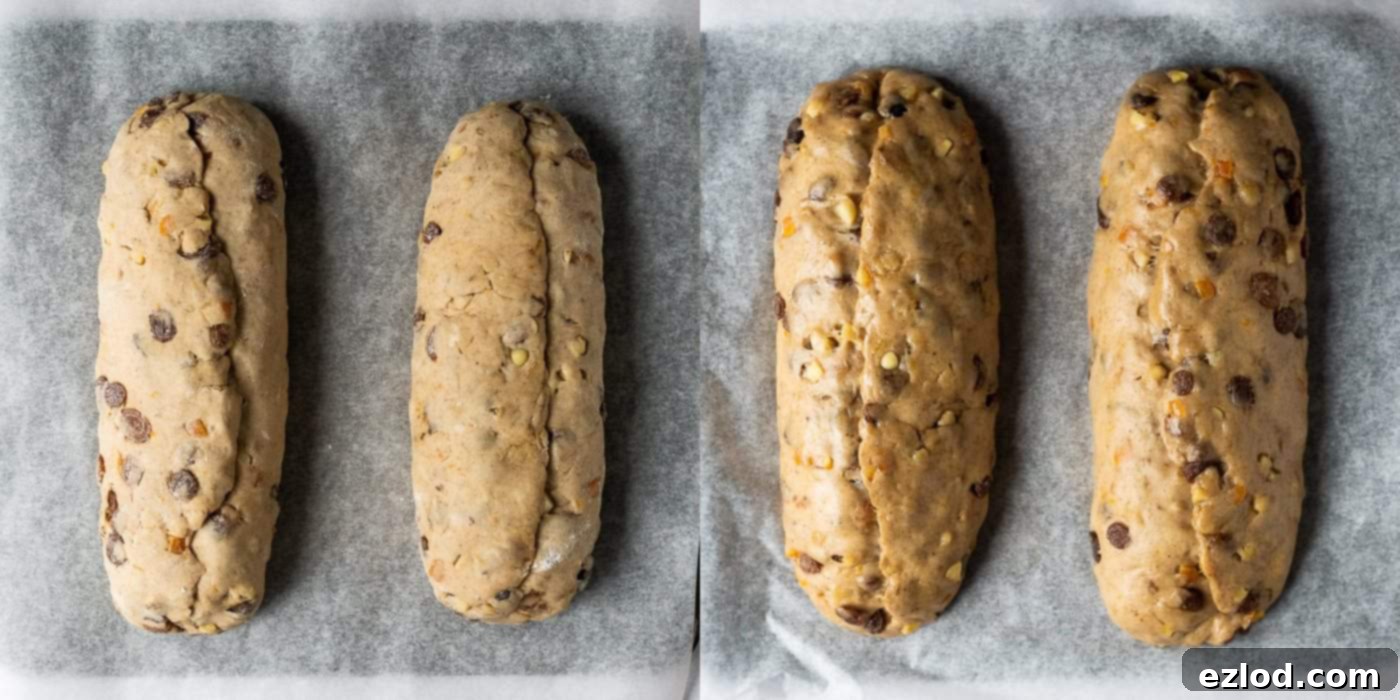
Once the loaves appear visibly puffy, indicating a successful second rise, bake them for 40-45 minutes. The most accurate way to check for doneness is to use a probe thermometer; the internal temperature should register at least 94°C/201°F. If the stollen starts to brown too quickly, lightly tent it with tin foil to prevent over-browning.
Upon removing the baked stollen from the oven, let them cool on the baking sheet for about 10 minutes. This is also the ideal time to carefully pick off any raisins that may have risen to the surface and become burnt or bitter during baking.
While still warm, brush the stollen very generously with melted vegan butter. This not only adds to the richness but also helps to seal the crust. Allow this butter layer to set completely.
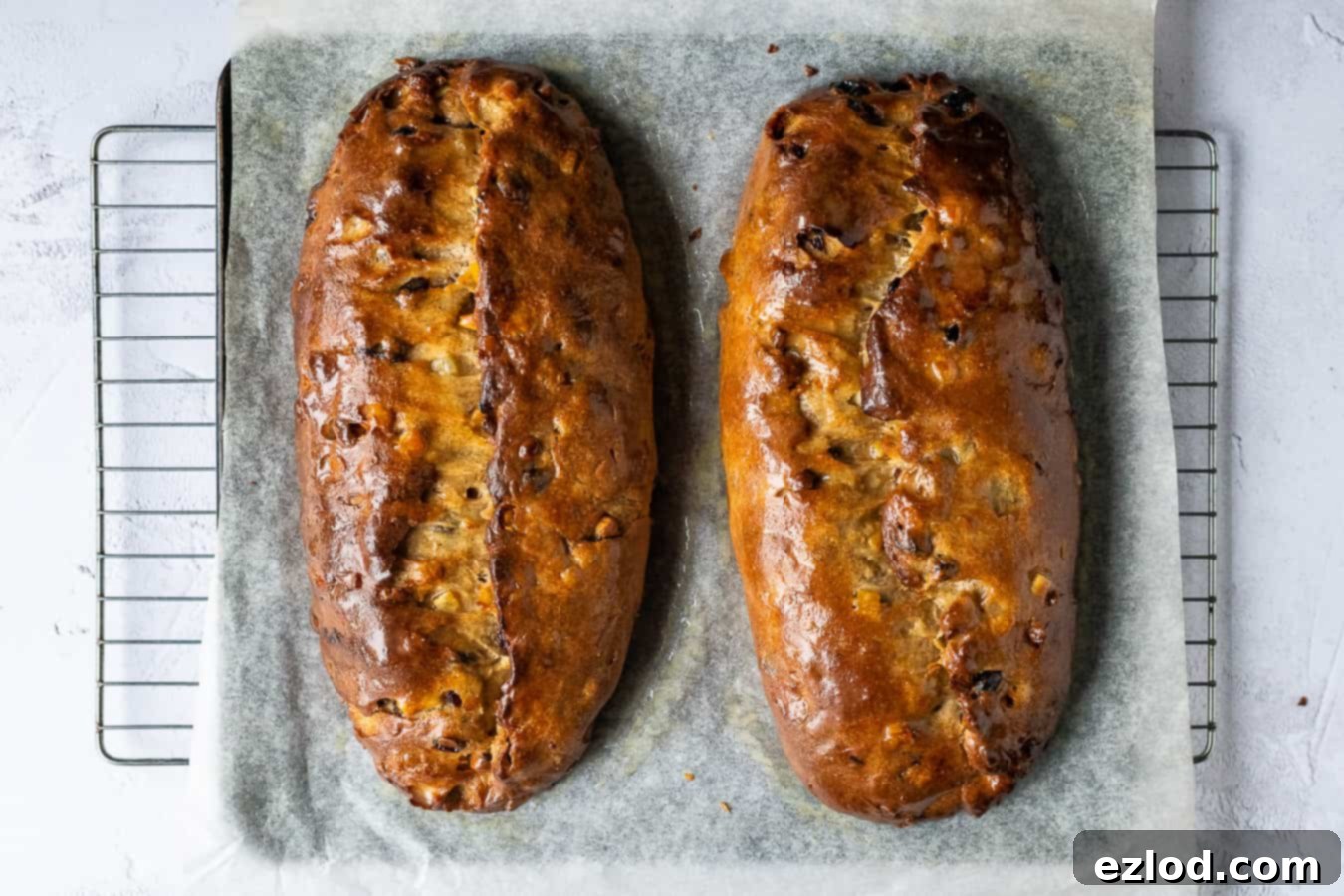
Once the butter has set, liberally dust the loaves with a thick layer of sifted icing sugar. This final sugary coat is not just for aesthetics; it forms a protective barrier that locks in moisture and further enhances the stollen’s shelf life. Let the stollen cool completely before wrapping and storing.
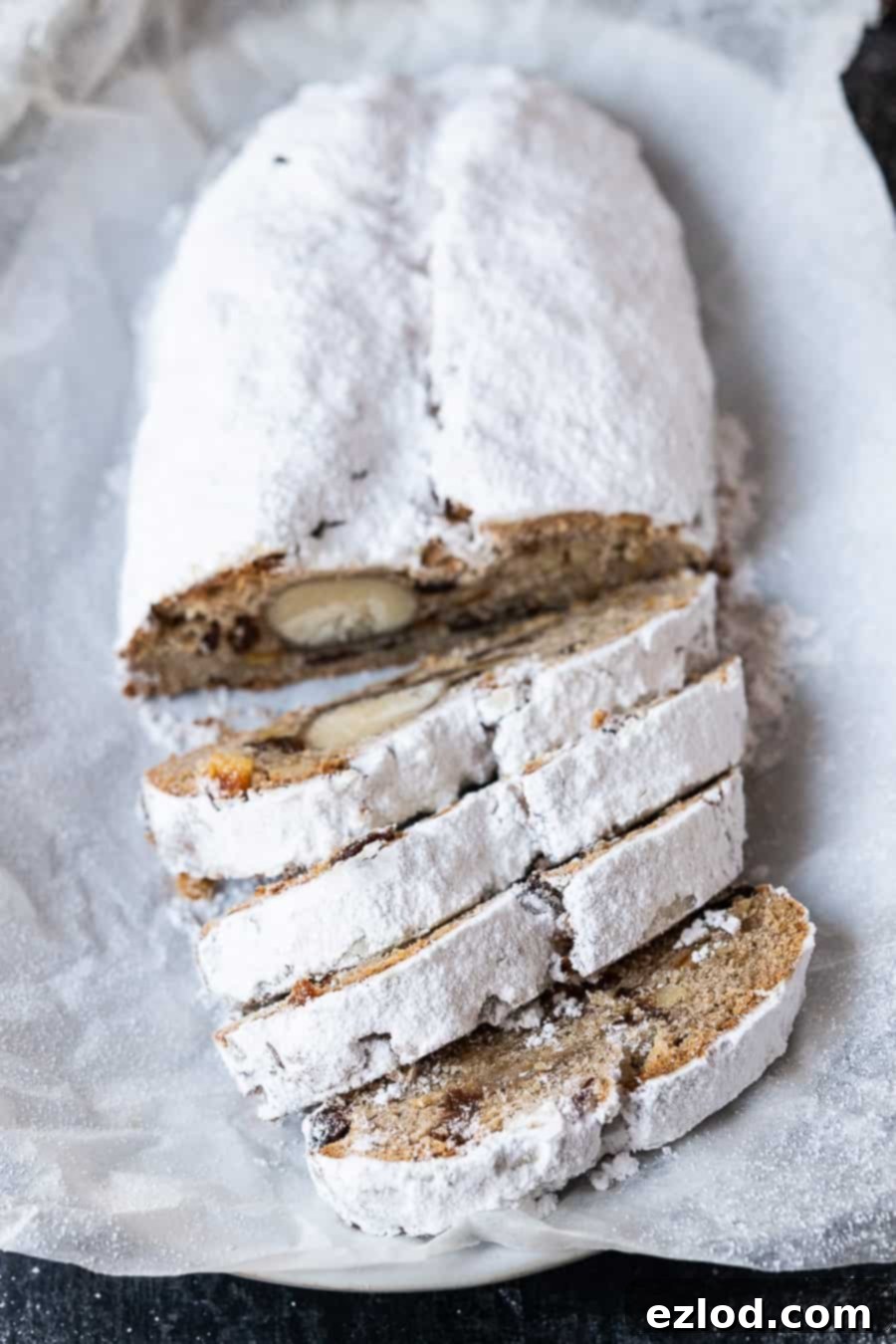
Top Tips for Stollen Perfection:
- Fat Content is Key: Stollen is traditionally made with a very high fat content – often half the amount of flour. Do not reduce the vegan butter in this recipe; it’s essential for achieving the desired moist, tender texture and for extending its shelf life. Skimping on fat will result in a dry bread that won’t keep well.
- Choose the Right Flour: While bread flour is common for many yeasted breads, for stollen, plain (all-purpose) flour is preferred. Its lower protein content contributes to the desired cake-like, tender crumb rather than a chewy bread texture.
- Opt for Block Vegan Butter: For the best results, use a firm block of vegan butter or margarine. These mimic traditional butter more closely than spreadable tub varieties, which often contain more water and less fat, impacting the dough’s structure and richness. Naturli Vegan Block is a fantastic choice.
- Assisting the Rise (if needed): If your kitchen is particularly cold, you can create a warm environment for your dough. Briefly warm your oven on a very low setting, then switch it off and open the door for about 30 seconds to release some heat. Place the covered dough inside with the door slightly ajar.
- Confirm Doneness with a Thermometer: The most reliable way to ensure your stollen is perfectly baked through is to check its internal temperature with a probe thermometer. It should reach a minimum of 94°C/201°F.
- The Art of Maturation: While you can enjoy your stollen immediately (after it has cooled completely!), its flavour and texture will significantly improve if you allow it to mature. Wrap each loaf tightly in baking parchment, then tin foil, and store it in a cool, dry place for one to two weeks before slicing. This period allows the flavors to meld and deepen beautifully.
- Perfect for Gifting: Thanks to its excellent keeping qualities, a well-wrapped stollen can last for up to six weeks. This makes it an ideal homemade Christmas gift for friends, family, and neighbours.
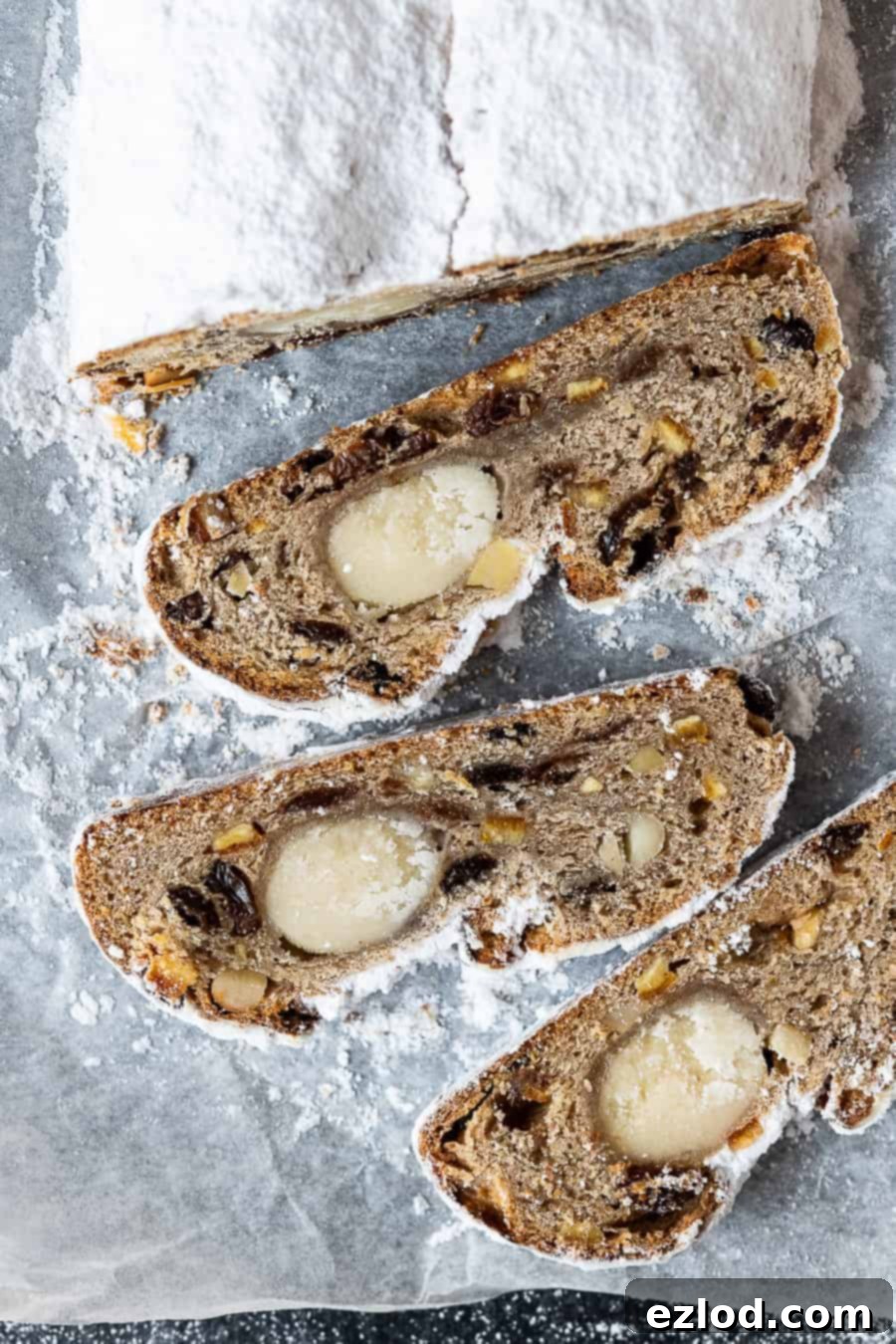
How To Store Vegan Stollen:
Proper storage is essential to maintain your stollen’s moistness and extend its shelf life. Once the loaves are baked, and while they are still warm, brush them generously all over with melted vegan butter. Allow this butter to set, then apply a very thick layer of icing (powdered) sugar. This butter and sugar coating acts as a protective seal, locking in moisture and preventing the bread from drying out. Do not skip this crucial step!
After the loaves have cooled completely, wrap each one first in a layer of baking parchment, then in a layer of tin foil. Store them in a cool, dark place, such as a pantry or a cool cupboard, where they will keep beautifully for up to six weeks, becoming even more flavourful with time.
Can I Freeze Vegan Stollen?:
Absolutely! Vegan stollen freezes exceptionally well. Once the loaves are completely cool and properly wrapped as described above (parchment and foil), they can be frozen for up to three months. To enjoy, simply allow them to defrost slowly at room temperature. This makes it a fantastic make-ahead option for holiday entertaining.
More Delightful Vegan Christmas Recipes:
- Vegan Mince Pies
- Vegan Christmas Cake
- Vegan Christmas Pudding
- Vegan Mincemeat Cake
- Vegan Mulled Wine Brownies
- Vegan Steamed Chocolate Pudding
- Chocolate Gingerbread Cookies
- Starry Mince Pie Tart
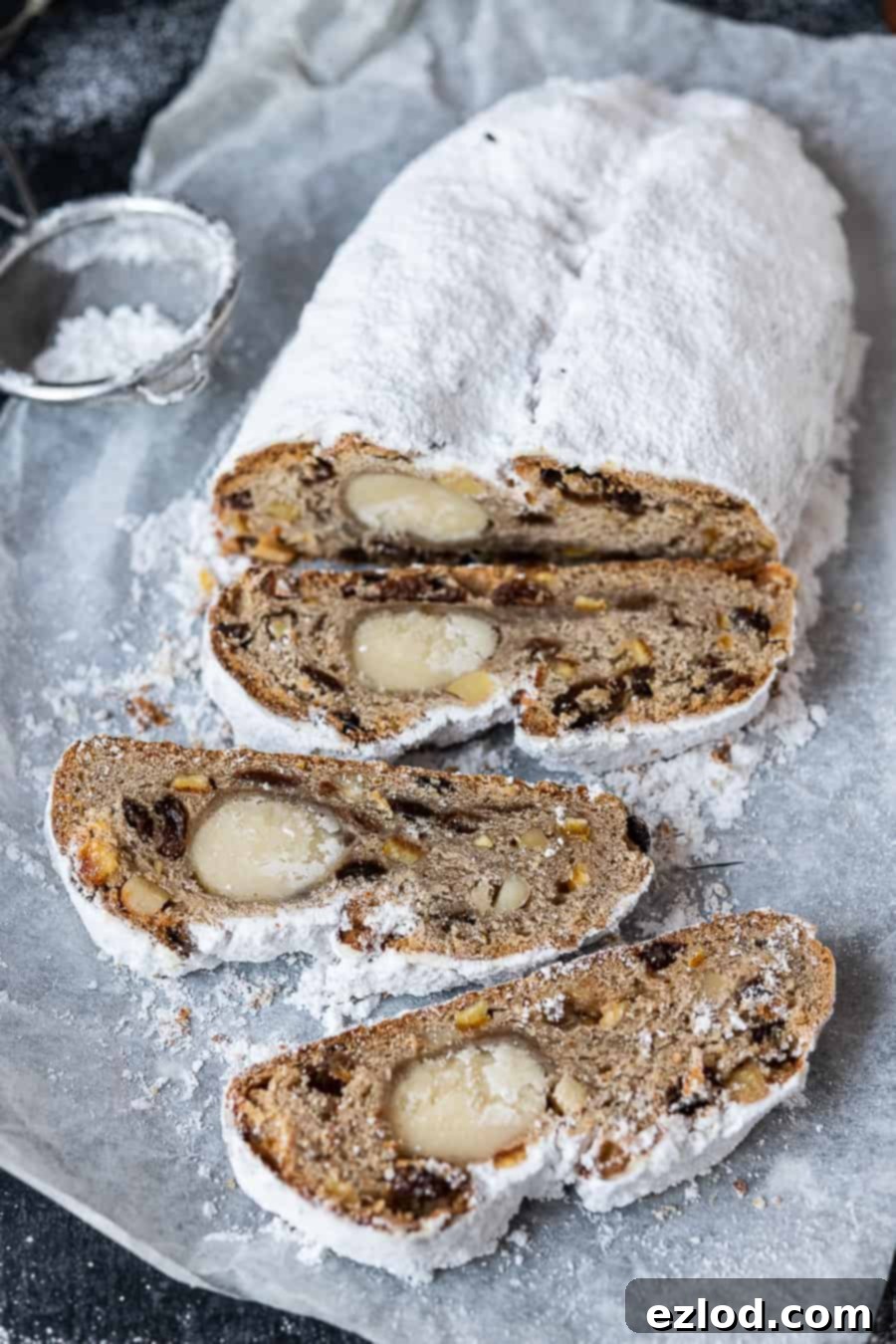
If you tried this delightful vegan stollen recipe, we’d love to see your creations! Tag @domestic_gothess on Instagram and use the hashtag #domesticgothess. Happy baking!
*All images and content on Domestic Gothess are copyright protected. If you wish to share this recipe, please do so by using the provided share buttons. Please do not screenshot or post the recipe or content in full.*

Print
Vegan Stollen
Ingredients
Fruit Mixture:
- 250 g (9 oz) raisins
- 125 g (4 ½ oz) candied mixed peel
- 50 ml (3 Tbsp + 1 tsp) rum
- 50 g (1 ¾ oz) chopped almonds
Stollen Dough:
- 500 g (4 cups) plain (all-purpose) flour
- 10 g (2 ½ tsp) instant/fast action yeast
- 100 g (½ cup) caster/granulated sugar
- 1 tsp salt
- 1 tsp ground cinnamon
- 1 tsp ground allspice
- ½ tsp ground cardamom
- ½ tsp ground nutmeg
- ¼ tsp ground cloves
- 200 ml (½ + ⅓ cup) lukewarm unsweetened non-dairy milk (soy is best)
- 1 tsp almond extract
- 1 tsp vanilla extract
- finely grated zest of 1 orange
- finely grated zest of 1 lemon
- 250 g (9 oz) vegan block butter (I use Naturli Vegan Block) softened
- 300 g (10 ½ oz) marzipan
To Finish:
- 50 g (1 ¾ oz) vegan block butter melted
- icing (powdered) sugar for dusting
Instructions
Day 1:
-
You need to make this stollen over the course of three days. On the evening of the first day, mix together the raisins, candied mixed peel and rum. Give it a good stir, cover and leave to soak overnight.
Day 2:
-
The following day, stir the chopped almonds into the fruit mixture.
-
In the bowl of a stand mixer, mix together the plain flour, instant yeast, sugar, salt, ground cinnamon, allspice, cloves, cardamom and nutmeg.
-
Add the lukewarm non-dairy milk, vanilla and almond extracts, grated orange and lemon zest and softened vegan block butter.
-
Give it a good mix until it forms a rough dough then knead with the mixer on a high speed for about 10 minutes until the dough is very smooth and elastic and it comes away from the sides of the bowl cleanly.
-
If you don’t have a stand mixer you can knead the dough by hand on an unfloured surface for 10-15 minutes until it is smooth, stretchy and no longer sticky.
-
Add the soaked fruit and nut mixture and knead until it is well distributed.
-
Place the dough in a lightly oiled bowl, cover the bowl and set aside to rise in a warm spot until it has almost doubled in size. This can take 5-8 hours depending on how warm it is.
-
Once the dough has risen, place the covered bowl in the fridge overnight.
Day 3:
-
The following day, remove the bowl from the fridge and leave it to come up to room temperature for 2 hours.
-
Knock the dough back and divide it into two equal pieces (I use a scale for accuracy).
-
Roll each ball of dough out on a lightly floured surface to a rough rectangle about 1 – 1 ½ cm thick.
-
Divide the marzipan in half and roll each half into a log a little shorter than your dough rectangles. Place the marzipan logs just off centre on the dough.
-
Fold the smaller half of dough over the marzipan then fold the other half over the top and press gently to seal. Make sure that the ends are also sealed.
-
Place the logs well spaced apart on a greaseproof paper lined baking sheet and loosely cover. Set aside to rise in a warm place for 3-4 hours until they have increased in size by 50%. They will not double. Meanwhile preheat the oven to 180°C/350°F/gas mark 4.
-
Once the logs are puffy, bake them for 40-45 minutes until the internal temperature reaches at least 94°C/201°F on a probe thermometer. If they start to become too dark before they are ready you can loosely cover them with tin foil.
-
Once the stollen are baked, remove the logs from the oven and let cool for 10 minutes. Remove any raisins from the surface as they will be burnt and bitter.
-
Brush the stollen generously with the melted vegan butter and leave it to set.
-
Once the butter has set, sprinkle them with a thick layer of sifted icing sugar and leave to cool completely.
-
Once the stollen are completely cold, wrap them first in a layer of baking parchment then a layer of tin foil and store in a cool, dry place for up to six weeks.
Notes
- For the best results make sure that you follow the recipe closely. As always, I highly recommend using the gram measurements (with a digital scale), rather than the cup conversions. Cup measurements are simply not accurate enough for baking and I cannot guarantee the best results if you use them.
- See the post above for step-by-step photos.
- Stollen is supposed to have a very high fat content – half fat to flour. DO NOT reduce it otherwise the bread will be dry and won’t keep.
- I usually use bread flour when baking bread, but because we want a more cake-like texture here, plain (all-purpose) flour is the best choice.
- Ideally you should use a block butter/margarine rather than the spreadable kind in a tub for the best texture; I use Naturli Vegan Block.
- If it is a really cold day and you want to speed up the rising time of the dough a bit, you can warm up the oven a bit on a low heat, switch it off and open the door for 30 seconds to let out some of the heat then place the (covered) dough in the oven with the door slightly ajar.
- The best way to tell if bread is baked properly is to check the internal temperature with a probe thermometer. It should reach at least 94°C/201°F.
- You can eat the stollen right away if you want (let it cool completely first though!) but it will have the best flavour and texture if you wrap it up in baking parchment and tin foil and let it mature in a cool, dry place for one to two weeks before you slice it.
- Provided it is well wrapped, the stollen will keep for around six weeks so it is perfect to give as gifts for Christmas.
